Adaptive Passive-Control for Multi-Stage Seismic Response of High-Rise Braced Frame Using the Frictional-Yielding Compounded BRBs
Abstract
:1. Introduction
2. Working Principle and Mechanical Properties of FBRB
2.1. Working Principle of FBRB
2.2. Mechanical Properties of FBRB
3. Experimental Validation for the Proposed FBRB Construction
3.1. Construction Details of the FBRB Specimen
3.2. Measurement of the Friction Coefficient
3.3. Design of the FBRB Specimens
3.4. Reversed Cyclic Test of the Specimens
4. Parametric Design Procedures for FBRB-Equipped High-Rise Braced Frame
5. Evaluation on the Seismic Performance of FBRB-Equipped Braced Frame
5.1. The 48-Story FBRB-BF Earthquake Resisting System: Case Study
5.1.1. Information of the Structure for Case Study
5.1.2. Parametric Design of FBRB for the Sample Structure
5.2. Numerical Modeling of the 48-Story FBRB-BF Structure
5.3. Evaluations on the Seismic Responses of FBRB-BF and BRB-BF
5.3.1. Lateral Drift Response
5.3.2. Seismic Energy Analysis
5.3.3. Distributions of Inter-Story Shear Forces
6. Conclusions
- (1)
- The FBRB device, characterized by the multi-stage passive control and energy dissipation, was proposed. The quasi-static test revealed that a maximum of 3% axial strain in the BRB steel core and a peak load of 1183 kN were achieved in the specimen, while maintaining steady and plump-hysteretic behavior. The construction details and hysteretic behavior of FBRB were experimentally validated.
- (2)
- A parametric-design procedure was developed which could be applied to preliminarily determine the FBRB parameters in FBRB-BF. The case study indicates that the method may yield unconservative results in some cases since the response-spectrum method is likely to underestimate the seismic forces at long periods. Dynamic time-history analysis is suggested to be supplemented, and the parameters should be modified if necessary.
- (3)
- FBRB significantly reduced the structural inter-story drift ratio under FOE, compared with the conventional BRB (up to 20%). The FD in FBRB dissipated 13%~42% of the seismic-input energy under FOE, validating the efficiency of FBRB in vibration reduction under FOE.
- (4)
- The ratio of energy dissipation for the BRB steel core in FBRB gradually rose with the increase of earthquake intensity. The FD in FBRB consumed comparable seismic energy as the BRB steel core at nonlinear stage, which is conducive to the relief of frame damage and improving the low-cycle fatigue performance of BRB steel core.
- (5)
- The story-shear forces in FBRB-BF were generally smaller than those in BRB-BF because of the effect of FD in FBRB. The phenomenon was especially obvious under the FOE case. FBRB exhibited preferable adaptive passive-control capability, and can be promoted in practical engineering.
Author Contributions
Funding
Institutional Review Board Statement
Informed Consent Statement
Data Availability Statement
Conflicts of Interest
References
- David, R.G.; Sarif, N. Seismic performance of eccentrically braced frames. In Proceedings of the 7th International Conference on Intelligent Textiles & Mass Customisation, Marrakech, Morocco, 13–15 November 2019; IOP Conference Series: Materials Science and Engineering. IOP Publishing: London, UK, 2020; p. 12021. [Google Scholar]
- Abou-Elfath, H.; Ramadan, M.; Alkanai, F.O. Upgrading the seismic capacity of existing RC buildings using buckling restrained braces. Alex. Eng. J. 2017, 56, 251–262. [Google Scholar] [CrossRef]
- Tremblay, R.; Poncet, L.; Bolduc, P.; Neville, R.; DeVall, R. Testing and design of buckling restrained braces for Canadian application. In Proceedings of the 13th World Conference on Earthquake Engineering, Vancouver, BC, Canada, 1–6 August 2004; pp. 1–6. [Google Scholar]
- Naghavi, M.; Rahnavard, R.; Thomas, R.J.; Malekinejad, M. Numerical evaluation of the hysteretic behavior of concentrically braced frames and buckling restrained brace frame systems. J. Build. Eng. 2019, 22, 415–428. [Google Scholar] [CrossRef]
- Chen, H.; Bai, J. Loading protocols for seismic performance evaluation of buckling-restrained braces in RC frames. J. Build. Eng. 2022, 45, 103522. [Google Scholar] [CrossRef]
- Bai, J.; Chen, H.; Zhao, J.; Liu, M.; Jin, S. Seismic design and subassemblage tests of buckling-restrained braced RC frames with shear connector gusset connections. Eng. Struct. 2021, 23, 4112018. [Google Scholar] [CrossRef]
- Takeuchi, T. Buckling-restrained brace: History, design and applications. In Key Engineering Materials; Trans Tech Publications Ltd.: Seestrasse, Switzerland, 2018; pp. 50–60. [Google Scholar]
- Almeida, A.; Ferreira, R.; Proença, J.M.; Gago, A.S. Seismic retrofit of RC building structures with Buckling Restrained Braces. Eng. Struct. 2017, 130, 14–22. [Google Scholar] [CrossRef]
- Castaldo, P.; Tubaldi, E.; Selvi, F.; Gioiella, L. Seismic performance of an existing RC structure retrofitted with buckling restrained braces. J. Build. Eng. 2021, 33, 101688. [Google Scholar] [CrossRef]
- Xie, Q. State of the art of buckling-restrained braces in Asia. J. Constr. Steel Res. 2005, 61, 727–748. [Google Scholar] [CrossRef]
- Wang, C.; Chen, Q.; Zeng, B.; Meng, S. A novel brace with partial buckling restraint: An experimental and numerical investigation. Eng. Struct. 2017, 150, 190–202. [Google Scholar] [CrossRef]
- Kimura, K.; Yoshioka, K.; Takeda, T.; Fukuya, Z.; Takemoto, K. Tests on braces encased by mortar in-filled steel tubes. In Summaries of Technical Papers of Annual Meeting; Architectural Institute of Japan: Tokyo, Japan, 1976; pp. 1041–1042. [Google Scholar]
- Watanabe, A.; Hitomi, Y.; Saeki, E.; Wada, A.; Fujimoto, M. Properties of brace encased in buckling-restraining concrete and steel tube. In Proceedings of the Ninth World Conference on Earthquake Engineering, Tokyo, Japan, 2–9 August 1988; pp. 719–724. [Google Scholar]
- Suzuki, N.; Kono, R.; Higasibata, Y.; Sasaki, T.; Segawa, T. Experimental study on the H-section steel brace encased in RC or steel tube. In Summaries of Technical Papers of Annual Meeting; Architectural Institute of Japan: Tokyo, Japan, 1994; pp. 1621–1622. [Google Scholar]
- Tremblay, R.; Bolduc, P.; Neville, R.; DeVall, R. Seismic testing and performance of buckling-restrained bracing systems. Can. J. Civil Eng. 2006, 33, 183–198. [Google Scholar] [CrossRef]
- Black, C.J.; Makris, N.; Aiken, I.D. Component testing, seismic evaluation and characterization of buckling-restrained braces. J. Struct. Eng. 2004, 130, 880–940. [Google Scholar] [CrossRef]
- Wang, C.; Usami, T.; Funayama, J. Evaluating the influence of stoppers on the low-cycle fatigue properties of high-performance buckling-restrained braces. Eng. Struct. 2012, 41, 167–176. [Google Scholar] [CrossRef]
- Takeuchi, T.; Hajjar, J.F.; Matsui, R.; Nishimoto, K.; Aiken, I.D. Local buckling restraint condition for core plates in buckling restrained braces. J. Constr. Steel. Res. 2010, 66, 139–149. [Google Scholar] [CrossRef]
- Takeuchi, T.; Ida, M.; Yamada, S.; Suzuki, K. Estimation of cumulative deformation capacity of buckling restrained braces. J. Struct. Eng. 2008, 134, 822–831. [Google Scholar] [CrossRef]
- Zona, A.; Dall’Asta, A. Elastoplastic model for steel buckling-restrained braces. J. Constr. Steel. Res. 2012, 68, 118–125. [Google Scholar] [CrossRef]
- Asgarian, B.; Amirhesari, N. A comparison of dynamic nonlinear behavior of ordinary and buckling restrained braced frames subjected to strong ground motion. Struct. Des. Tall Spec. Build. 2008, 17, 367–386. [Google Scholar] [CrossRef]
- Fahnestock, L.A.; Ricles, J.M.; Sause, R. Experimental evaluation of a large-scale buckling-restrained braced frame. J. Struct. Eng. 2007, 133, 1205–1214. [Google Scholar] [CrossRef]
- Mazzolani, F.M.; Corte, G.D.; D’Aniello, M. Experimental analysis of steel dissipative bracing systems for seismic upgrading. J. Civ. Eng. Manag. 2009, 15, 7–19. [Google Scholar] [CrossRef] [Green Version]
- Mahrenholtz, C.; Lin, P.C.; Wu, A.C.; Tsai, K.C.; Hwang, S.J.; Lin, R.Y.; Bhayusukma, M.Y. Retrofit of reinforced concrete frames with buckling-restrained braces. Earthq. Eng. Struct. Dyn. 2015, 44, 59–78. [Google Scholar] [CrossRef]
- Sabelli, R.; Mahin, S.; Chang, C. Seismic demands on steel braced frame buildings with buckling-restrained braces. Eng. Struct. 2003, 25, 655–666. [Google Scholar] [CrossRef]
- Choi, H.; Kim, J. Energy-based seismic design of buckling-restrained braced frames using hysteretic energy spectrum. Eng. Struct. 2006, 28, 304–311. [Google Scholar] [CrossRef]
- Maley, T.J.; Sullivan, T.J.; Corte, G.D. Development of a displacement-based design method for steel dual systems with buckling-restrained braces and moment-resisting frames. J. Earthq. Eng. 2010, 14, 106–140. [Google Scholar] [CrossRef]
- Sahoo, D.R.; Chao, S. Performance-based plastic design method for buckling-restrained braced frames. Eng. Struct. 2010, 32, 2950–2958. [Google Scholar] [CrossRef]
- Wararuksajja, W.; Leelataviwat, S.; Warnitchai, P.; Bing, L.; Tariq, H.; Naiyana, N. Seismic Strengthening of Soft-Story RC Moment Frames. In Proceedings of the 25th National Convention on Civil Engineering, Chonburi, Thailand, 15–17 July 2020; pp. STR47 1–STR47 7. [Google Scholar]
- Zhou, X.; Sun, T.; Sun, B.; Ma, N.; Ou, J. Vibration-Reduction Strategy for High-Rise Braced Frame Using Viscoelastic-Yielding Compounded BRB. Buildings 2022, 12, 1159. [Google Scholar] [CrossRef]
- Miller, D.J.; Fahnestock, L.A.; Eatherton, M.R. Development and experimental validation of a nickel–titanium shape memory alloy self-centering buckling-restrained brace. Eng. Struct. 2012, 40, 288–298. [Google Scholar] [CrossRef]
- Nazarimofrad, E.; Shokrgozar, A. Seismic performance of steel braced frames with self-centering buckling-restrained brace utilizing superelastic shape memory alloys. Struct. Des. Tall Spec. Build. 2019, 28, e1666. [Google Scholar] [CrossRef]
- Chou, C.; Tsai, W.; Chung, P. Development and validation tests of a dual-core self-centering sandwiched buckling-restrained brace (SC-SBRB) for seismic resistance. Eng. Struct. 2016, 12, 130–141. [Google Scholar] [CrossRef]
- Xu, L.H.; Fan, X.W.; Li, Z.X. Cyclic behavior and failure mechanism of self-centering energy dissipation braces with pre-pressed combination disc springs. Earthq. Eng. Struct. Dyn. 2017, 46, 1065–1080. [Google Scholar] [CrossRef]
- Pan, P.; Li, W.; Nie, X.; Deng, K.; Sun, J. Seismic performance of a reinforced concrete frame equipped with a double-stage yield buckling restrained brace. Struct. Des. Tall Spec. Build. 2017, 26, e1335. [Google Scholar] [CrossRef]
- Kim, D.; Lee, C.; Ju, Y.K. Experimental investigation of hybrid buckling-restrained braces. Int. J. Steel Struct. 2017, 17, 245–255. [Google Scholar] [CrossRef]
- Kim, D.H.; Ju, Y.K.; Kim, M.H.; Kim, S.D. Wind-induced vibration control of tall buildings using hybrid buckling-restrained braces. Struct. Des. Tall Spec. Build. 2014, 23, 549–562. [Google Scholar] [CrossRef]
- López-Almansa, F.; De la Cruz, S.T.; Taylor, C. Experimental study of friction dissipators for seismic protection of building structures. Earthq. Eng. Eng. Vib. 2011, 10, 475–486. [Google Scholar] [CrossRef] [Green Version]
- Fitzgerald, T.F.; Anagnos, T.; Goodson, M.; Zsutty, T. Slotted bolted connections in aseismic design for concentrically braced connections. Earthq. Spectra 1989, 53, 83–91. [Google Scholar] [CrossRef]
- Pall, A.S.; Marsh, C. Response of friction damped braced frames. J. Struct. Eng. 1982, 108, 1313–1323. [Google Scholar] [CrossRef]
- Nims, D.K.; Richter, P.J.; Bachman, R.E. The use of the energy dissipating restraint for seismic hazard mitigation. Earthq. Spectra 1993, 9, 467–489. [Google Scholar] [CrossRef]
- Filiatrault, A. Seismic Design of Friction Damped Braced Steel Plane Frames by Energy Methods; University of British Columbia: Vancouver, BC, Canada, 1988. [Google Scholar]
- Filiatrault, A.; Cherry, S. Seismic design spectra for friction-damped structures. J. Struct. Eng. 1990, 116, 1334–1355. [Google Scholar] [CrossRef]
- Mualla, I.H.; Belev, B. Performance of steel frames with a new friction damper device under earthquake excitation. Eng. Struct. 2002, 24, 365–371. [Google Scholar] [CrossRef]
- Franchek, M.A.; Ryan, M.W.; Bernhard, R.J. Adaptive passive vibration control. J. Sound. Vib. 1996, 189, 565–585. [Google Scholar] [CrossRef]
- Gates, N.C. The Earthquake Response of Deteriorating Systems; California Institute of Technology: Pasadena, CA, USA, 1977. [Google Scholar]
- Sun, T.; Kurama, Y.C.; Ou, J. Practical displacement-based seismic design approach for PWF structures with supplemental yielding dissipators. Eng. Struct. 2018, 172, 538–553. [Google Scholar] [CrossRef]
- JGJ82-2011; Technical Specification for High Strength Bolt Connections of Steel Structures. Ministry of Housing and Urban-Rural Development of the People’s Republic of China: Beijing, China, 2011.
- GB/T 1972-2005; Disc Spring. Standardization Administration: Beijing, China, 2005.
- GB50011-2010; Code for Seismic Design of Buildings. Ministry of Construction of the People’s Republic of China: Beijing, China, 2010.
- Kang, J. Seismic performance analysis and design of high-rise buildings with energy dissipation devices under super-strong earthquake. Dalian University of Technology: Dalian, China, 2015. (In Chinese) [Google Scholar]
- Sun, B.; Zhang, Y.; Dai, D.; Wang, L.; Ou, J. Seismic fragility analysis of a large-scale frame structure with local nonlinearities using an efficient reduced-order Newton-Raphson method. Soil Dyn. Earthq. Eng. 2023, 164, 107559. [Google Scholar] [CrossRef]
- McKenna, F.; Fenves, G.L.; Scott, M.H.; Jeremic, B. Open System for Earthquake Engineering Simulation (OpenSees); Pacific Earthquake Engineering Research Center, Univeristy of California: Berkley, CA, USA, 2013. [Google Scholar]
- ASCE/SEI 41-06; Seismic Rehabilitation of Existing Buildings. American Society of Civil Engineers: Reston, VA, USA, 2007.
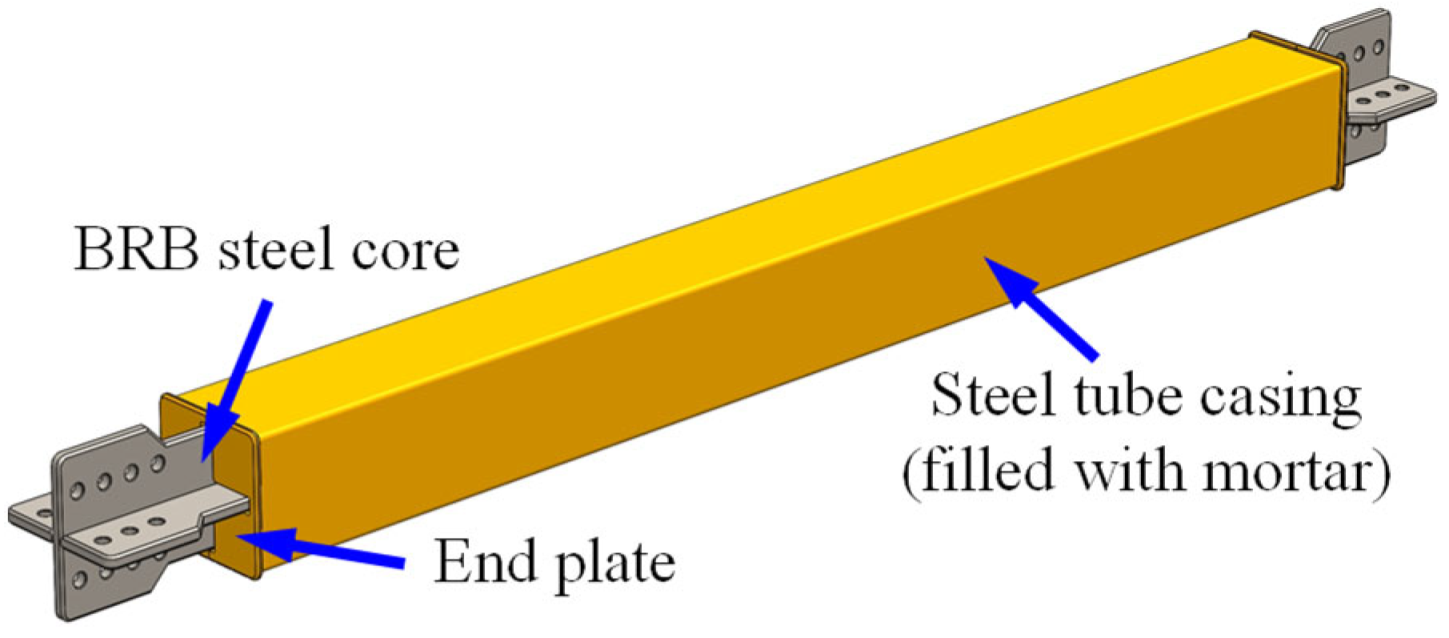


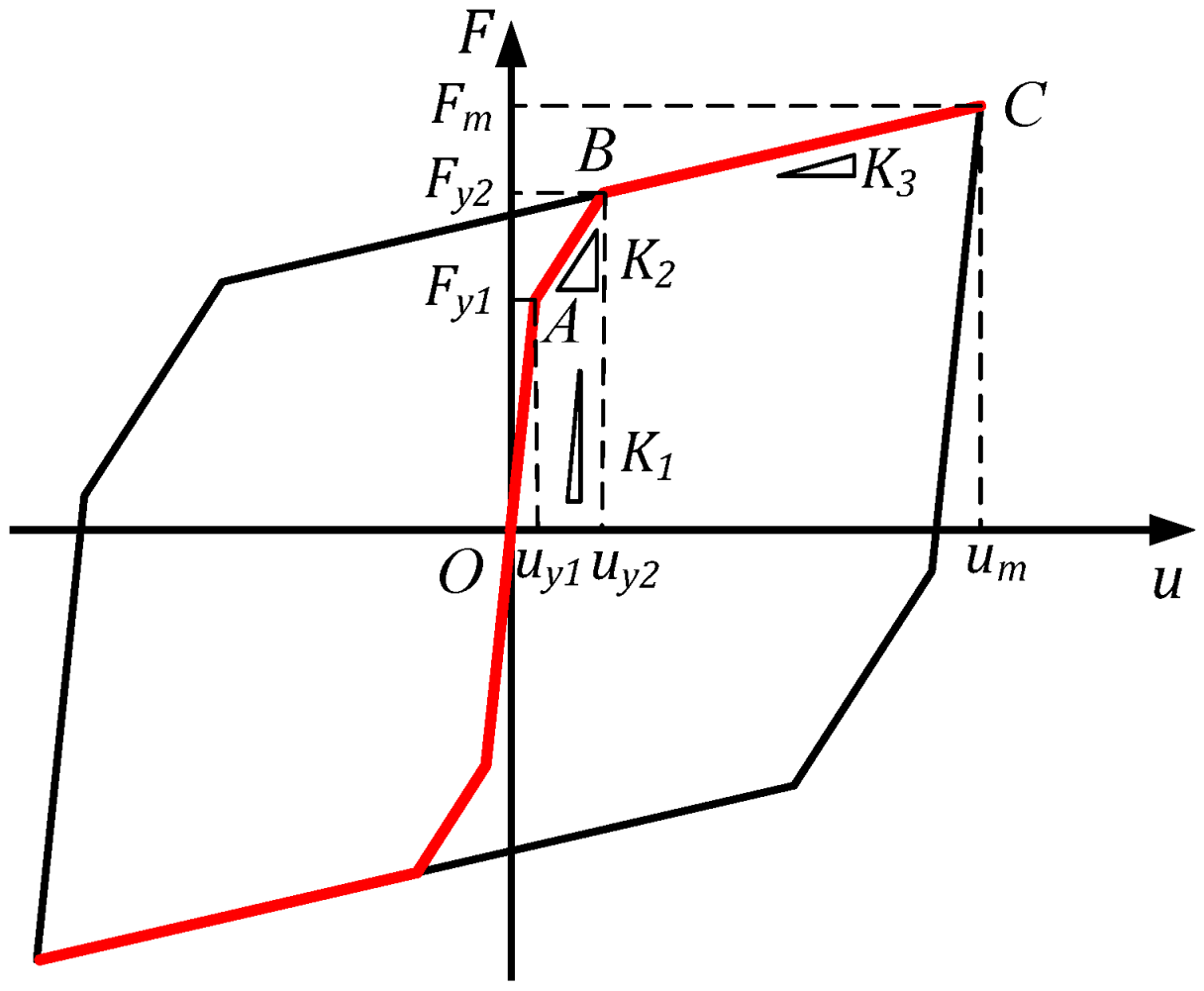


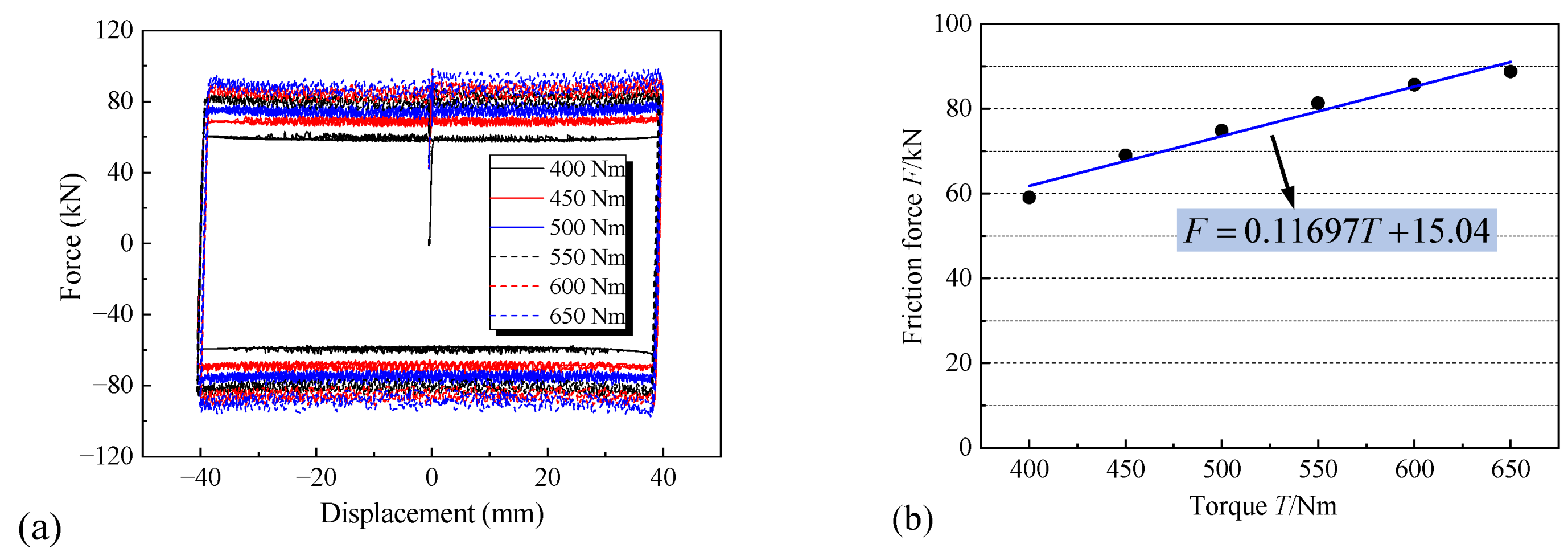
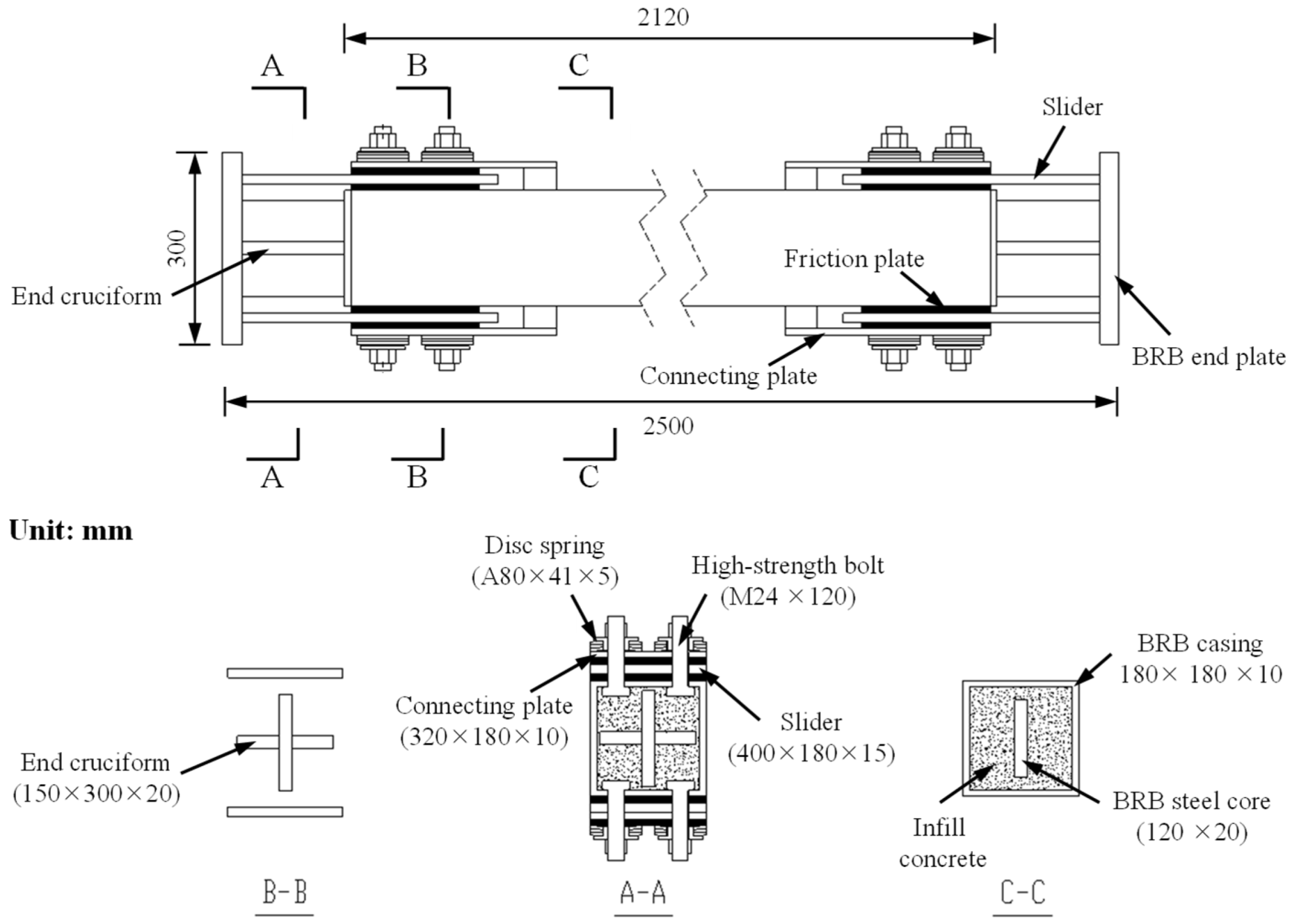

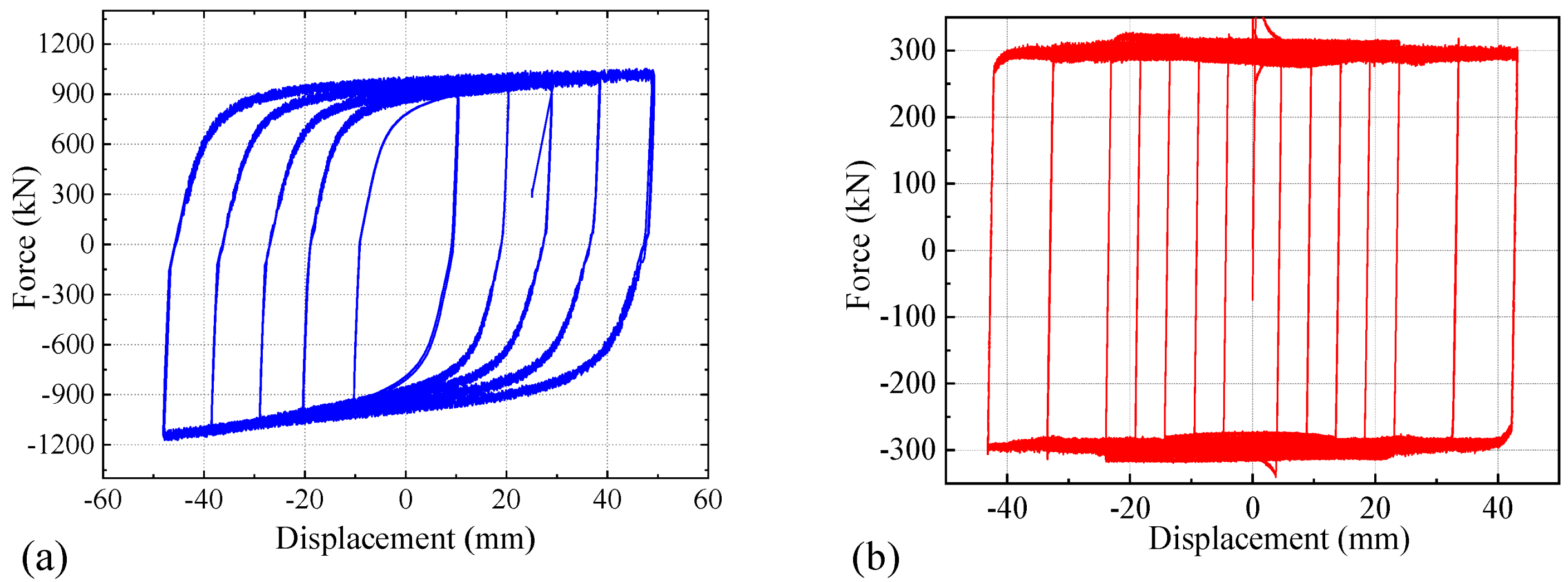
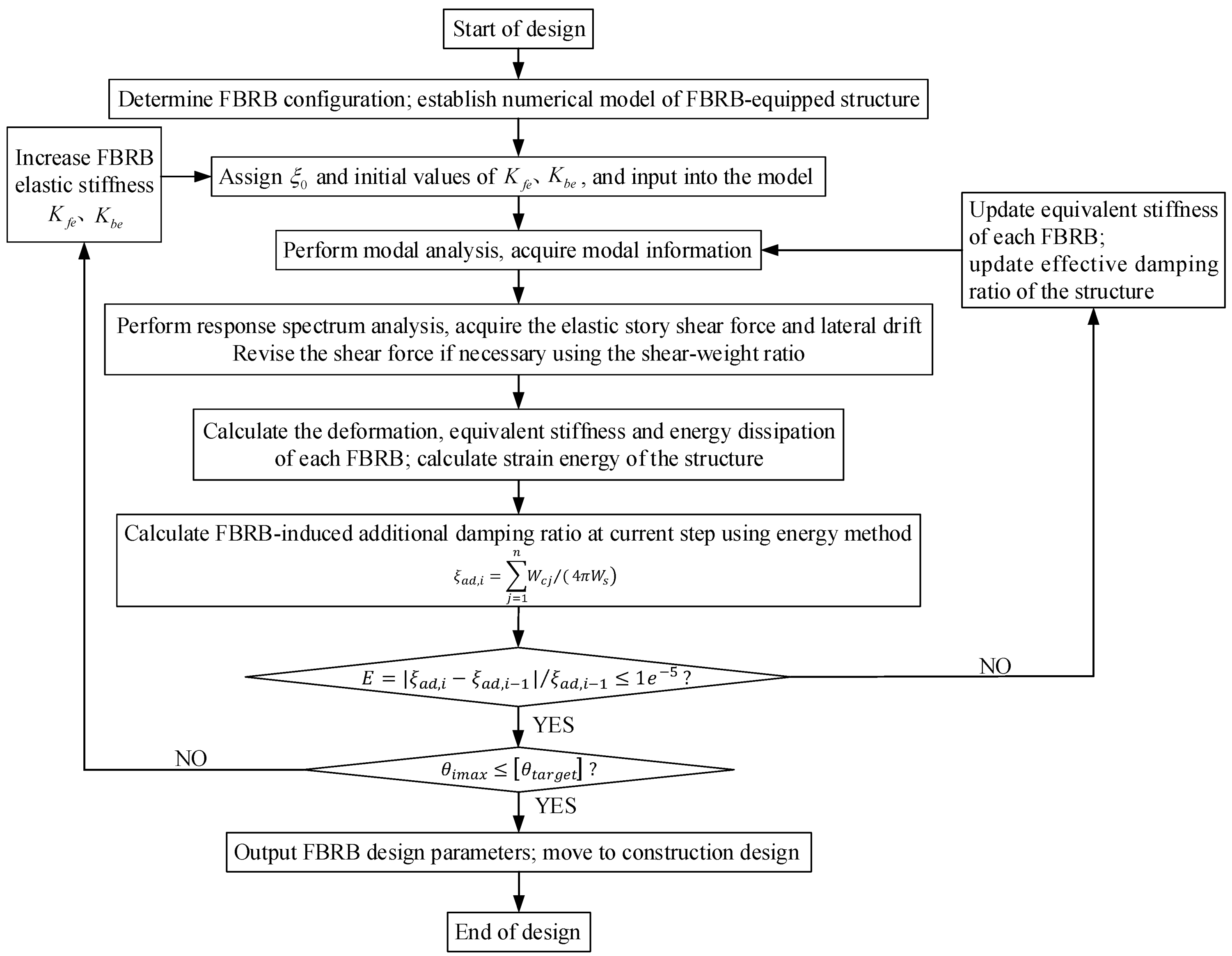

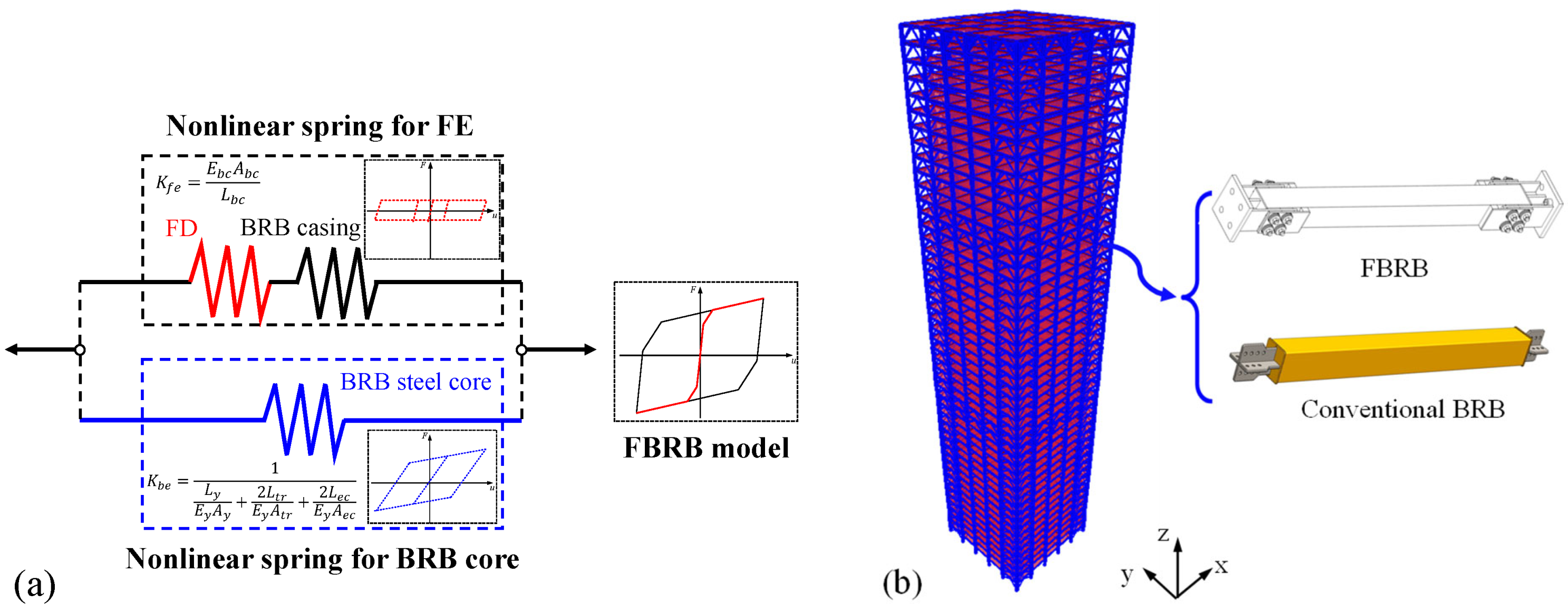



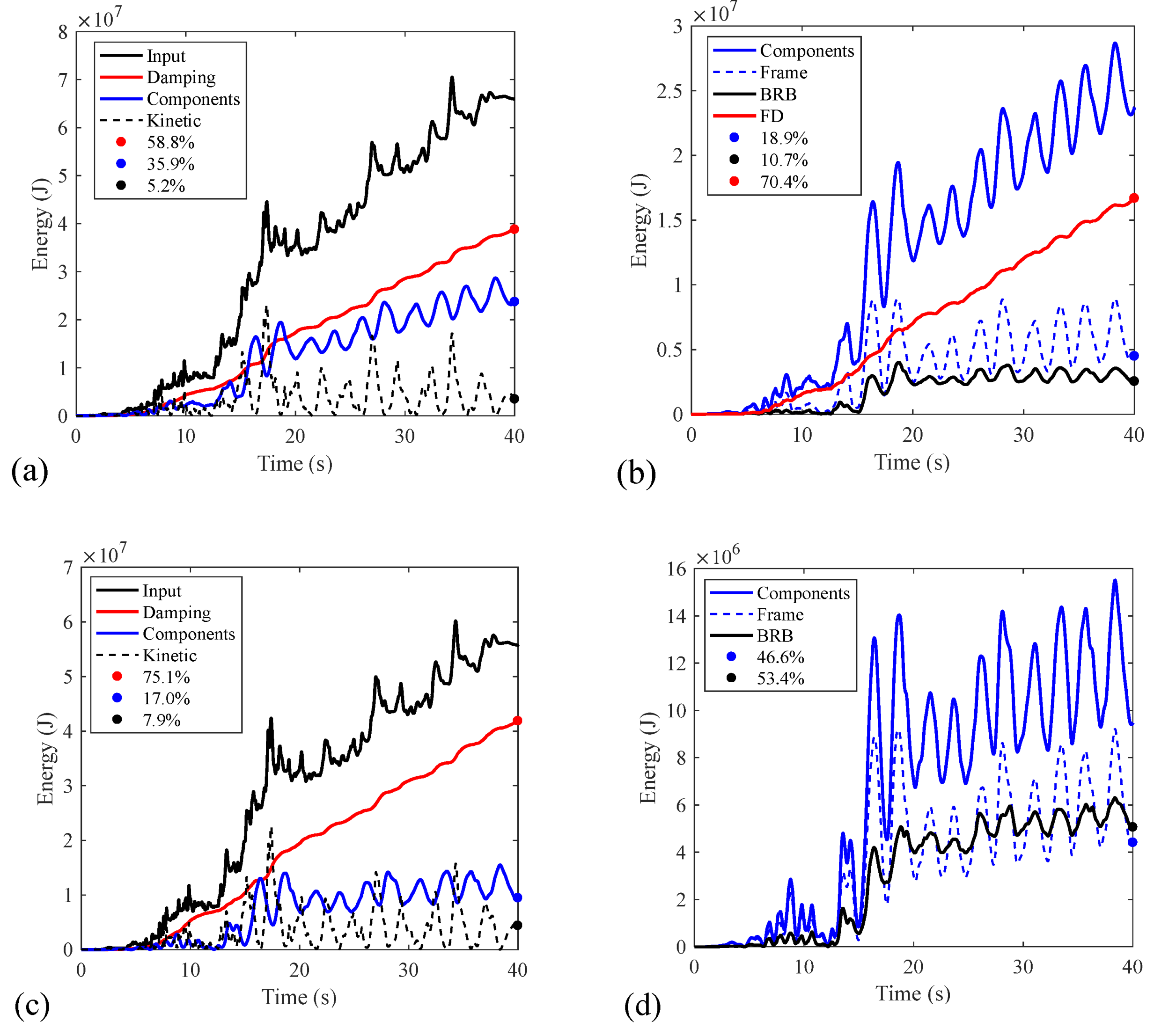
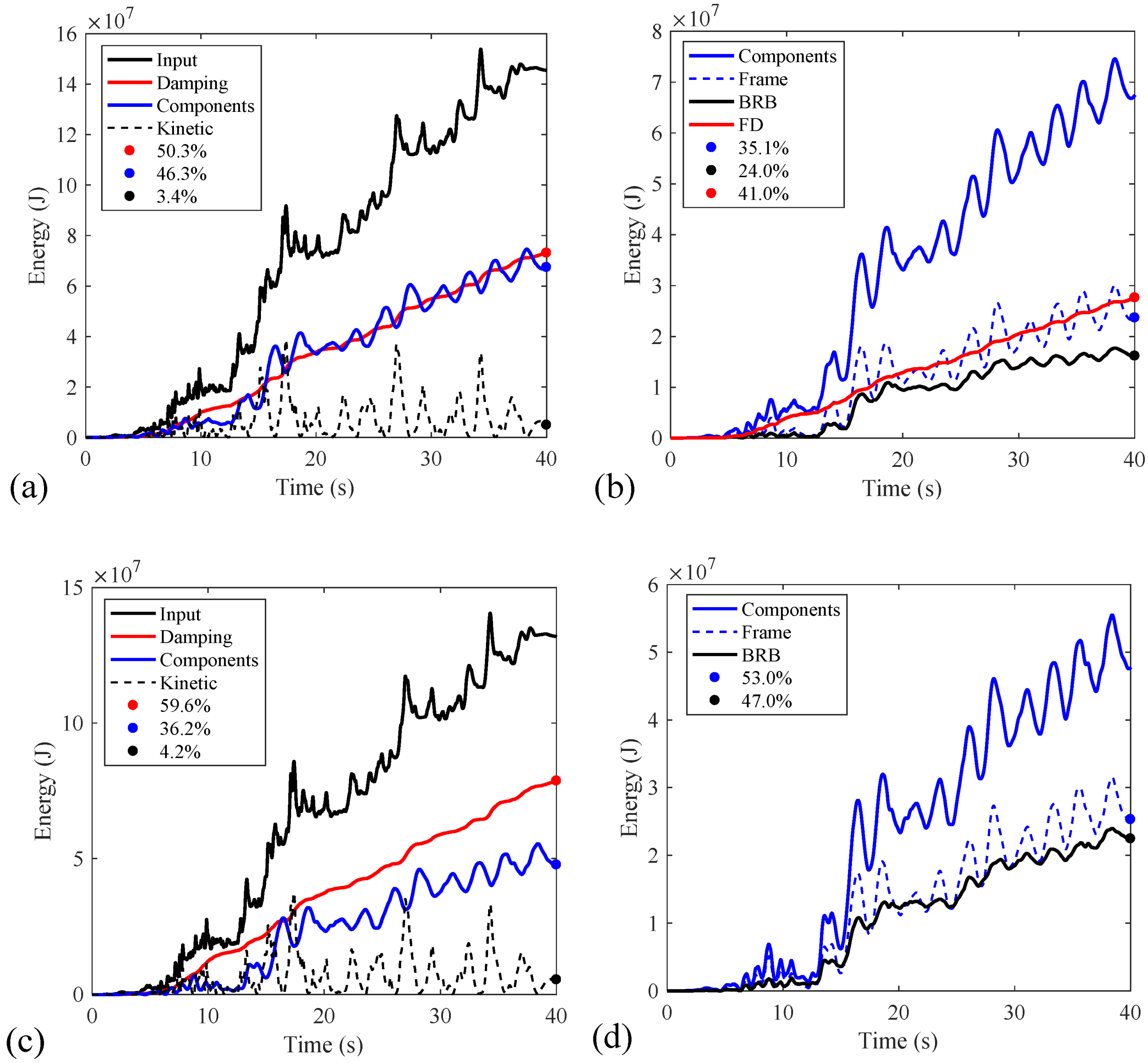


| No. | Material | Maximum Displacement (mm) | Torque Exerted on Bolts (Nm) | Repeated Cycles |
|---|---|---|---|---|
| FP | polymer composites | 40 | 400/450/500/550/600/650 | 3 |
| BRB | FD | |||||
|---|---|---|---|---|---|---|
| Overall Length (mm) | Length of Yield Segment (mm) | Area of Yield Segment (mm2) | Section of BRB Casing (mm) | Length of BRB Casing (mm) | Size of Friction Plates (mm) | Number of Friction Plates |
| 2500 | 1600 | 2400 | ☐180 × 180 × 10 | 2120 | 80 × 160 | 16 |
| BRB | FD | FBRB Ultimate Force (kN) | Yield-Displacement Ratio (R) | ||||
|---|---|---|---|---|---|---|---|
| Yield Displacement (mm) | Yield Force (kN) | Ultimate Axial Strain | Slide Displacement (mm) | Sliding Force (kN) | Friction Coefficient | ||
| 2.5 | 564 | 3% | 0.5 | 320 | 0.12 | 1200 | 5 |
| BRB | FD | ||||||
|---|---|---|---|---|---|---|---|
| Yield Displace-Ment (mm) | Yield Force (kN) | Force at 1/500 Drift Ratio (kN) | Post Yield Slope | Slide Displacement (mm) | Sliding Force (kN) | Energy Dissipated at 1/500 Drift Ratio (kNm) | Additional Damping Ratio |
| 8.1 | 1267.5 | 887.25 | 0.02 | 1.35 | 26 | 1352.82 | 7.99% |
| BRB | FD | |||||
|---|---|---|---|---|---|---|
| Overall Length (mm) | Length of Yield Segment (mm) | Area of Yield Segment (mm2) | Section of BRB Casing (mm) | Length of BRB Casing (mm) | Size of Friction Plates (mm) | Number of Friction Plates |
| 5657 | 4730 | 4436 | ☐220 × 220 × 8 × 8 | 4817 | 120 × 200 | 16 |
| 1st Order (x) | 1st Order (y) | 1st Order (Torsional) | 2nd Order (x) | 2nd Order (y) | 2nd Order (Torsional) | |
|---|---|---|---|---|---|---|
| FBRB-BF | 5.51 | 5.5 | 1.73 | 1.72 | 0.89 | 0.88 |
| BRB-BF | 6.07 | 6.05 | 1.96 | 1.95 | 1.03 | 1.02 |
Publisher’s Note: MDPI stays neutral with regard to jurisdictional claims in published maps and institutional affiliations. |
© 2022 by the authors. Licensee MDPI, Basel, Switzerland. This article is an open access article distributed under the terms and conditions of the Creative Commons Attribution (CC BY) license (https://creativecommons.org/licenses/by/4.0/).
Share and Cite
Zhou, X.; Sun, T.; Sun, B.; Ma, N.; Ou, J. Adaptive Passive-Control for Multi-Stage Seismic Response of High-Rise Braced Frame Using the Frictional-Yielding Compounded BRBs. Buildings 2022, 12, 2123. https://doi.org/10.3390/buildings12122123
Zhou X, Sun T, Sun B, Ma N, Ou J. Adaptive Passive-Control for Multi-Stage Seismic Response of High-Rise Braced Frame Using the Frictional-Yielding Compounded BRBs. Buildings. 2022; 12(12):2123. https://doi.org/10.3390/buildings12122123
Chicago/Turabian StyleZhou, Xiangzi, Tianshu Sun, Baoyin Sun, Ning Ma, and Jinping Ou. 2022. "Adaptive Passive-Control for Multi-Stage Seismic Response of High-Rise Braced Frame Using the Frictional-Yielding Compounded BRBs" Buildings 12, no. 12: 2123. https://doi.org/10.3390/buildings12122123
APA StyleZhou, X., Sun, T., Sun, B., Ma, N., & Ou, J. (2022). Adaptive Passive-Control for Multi-Stage Seismic Response of High-Rise Braced Frame Using the Frictional-Yielding Compounded BRBs. Buildings, 12(12), 2123. https://doi.org/10.3390/buildings12122123







